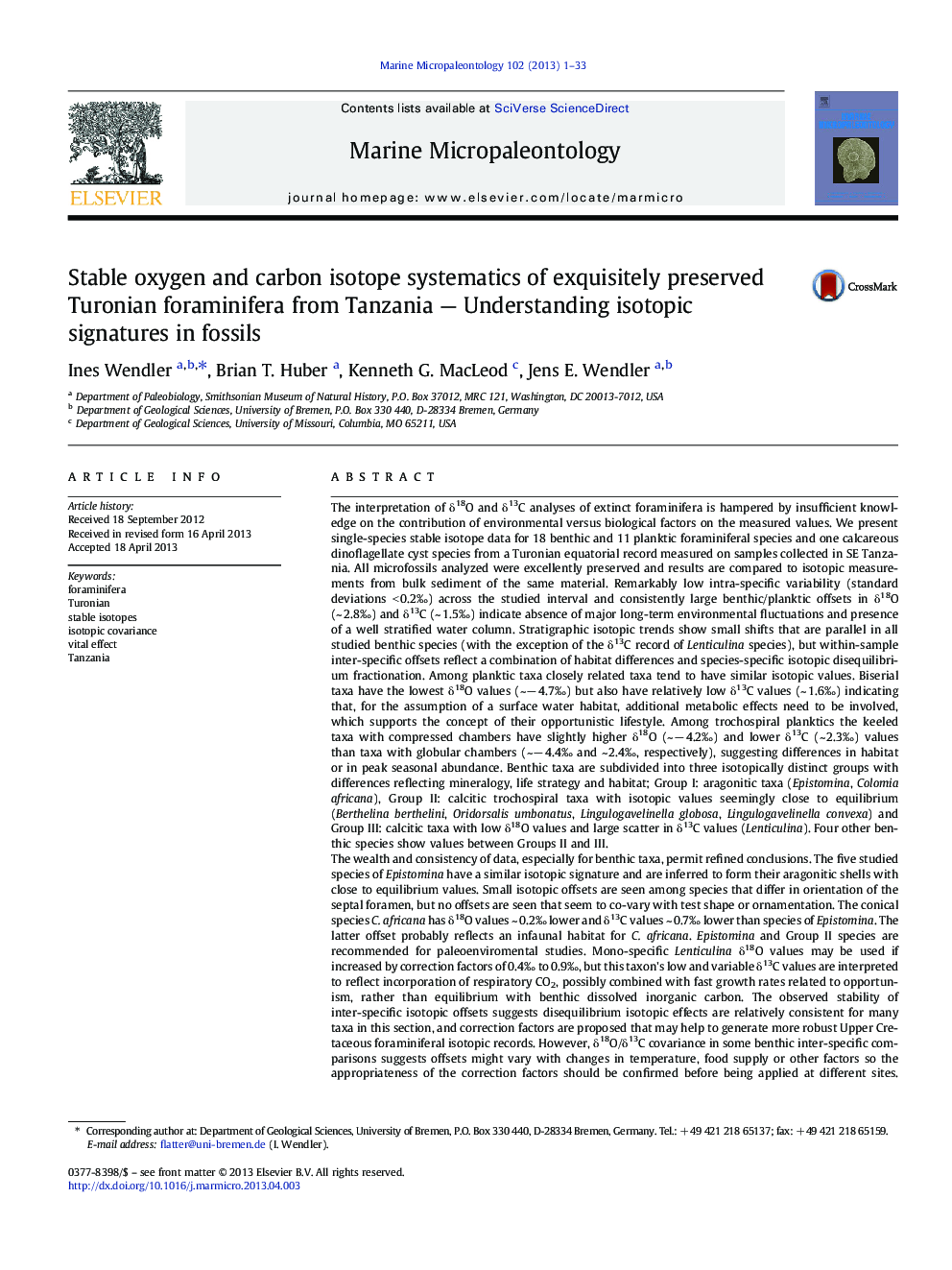| کد مقاله | کد نشریه | سال انتشار | مقاله انگلیسی | نسخه تمام متن |
|---|---|---|---|---|
| 4748914 | 1642183 | 2013 | 33 صفحه PDF | دانلود رایگان |

• We analyzed stable isotopes from 29 foraminiferal species of Turonian age (Tanzania).
• Six isotopically distinct groups reflect test mineralogy, life strategy and habitat.
• We identify nine benthic species with inferred near-equilibrium isotope values.
• Correction factors for species with δ18O and/or δ13C disequilibrium are proposed.
• A summarizing scheme of factors that influence foraminiferal isotopes is presented.
The interpretation of δ18O and δ13C analyses of extinct foraminifera is hampered by insufficient knowledge on the contribution of environmental versus biological factors on the measured values. We present single-species stable isotope data for 18 benthic and 11 planktic foraminiferal species and one calcareous dinoflagellate cyst species from a Turonian equatorial record measured on samples collected in SE Tanzania. All microfossils analyzed were excellently preserved and results are compared to isotopic measurements from bulk sediment of the same material. Remarkably low intra-specific variability (standard deviations < 0.2‰) across the studied interval and consistently large benthic/planktic offsets in δ18O (~ 2.8‰) and δ13C (~ 1.5‰) indicate absence of major long-term environmental fluctuations and presence of a well stratified water column. Stratigraphic isotopic trends show small shifts that are parallel in all studied benthic species (with the exception of the δ13C record of Lenticulina species), but within-sample inter-specific offsets reflect a combination of habitat differences and species-specific isotopic disequilibrium fractionation. Among planktic taxa closely related taxa tend to have similar isotopic values. Biserial taxa have the lowest δ18O values (~− 4.7‰) but also have relatively low δ13C values (~ 1.6‰) indicating that, for the assumption of a surface water habitat, additional metabolic effects need to be involved, which supports the concept of their opportunistic lifestyle. Among trochospiral planktics the keeled taxa with compressed chambers have slightly higher δ18O (~− 4.2‰) and lower δ13C (~ 2.3‰) values than taxa with globular chambers (~− 4.4‰ and ~ 2.4‰, respectively), suggesting differences in habitat or in peak seasonal abundance. Benthic taxa are subdivided into three isotopically distinct groups with differences reflecting mineralogy, life strategy and habitat; Group I: aragonitic taxa (Epistomina, Colomia africana), Group II: calcitic trochospiral taxa with isotopic values seemingly close to equilibrium (Berthelina berthelini, Oridorsalis umbonatus, Lingulogavelinella globosa, Lingulogavelinella convexa) and Group III: calcitic taxa with low δ18O values and large scatter in δ13C values (Lenticulina). Four other benthic species show values between Groups II and III.The wealth and consistency of data, especially for benthic taxa, permit refined conclusions. The five studied species of Epistomina have a similar isotopic signature and are inferred to form their aragonitic shells with close to equilibrium values. Small isotopic offsets are seen among species that differ in orientation of the septal foramen, but no offsets are seen that seem to co-vary with test shape or ornamentation. The conical species C. africana has δ18O values ~ 0.2‰ lower and δ13C values ~ 0.7‰ lower than species of Epistomina. The latter offset probably reflects an infaunal habitat for C. africana. Epistomina and Group II species are recommended for paleoenviromental studies. Mono-specific Lenticulina δ18O values may be used if increased by correction factors of 0.4‰ to 0.9‰, but this taxon's low and variable δ13C values are interpreted to reflect incorporation of respiratory CO2, possibly combined with fast growth rates related to opportunism, rather than equilibrium with benthic dissolved inorganic carbon. The observed stability of inter-specific isotopic offsets suggests disequilibrium isotopic effects are relatively consistent for many taxa in this section, and correction factors are proposed that may help to generate more robust Upper Cretaceous foraminiferal isotopic records. However, δ18O/δ13C covariance in some benthic inter-specific comparisons suggests offsets might vary with changes in temperature, food supply or other factors so the appropriateness of the correction factors should be confirmed before being applied at different sites. Similarities between the observed single-species isotopic patterns from this and other studies are used to present a summarizing scheme of influences on the stable isotopic composition in foraminiferal tests. By applying the new insights from our study to data from other Cretaceous studies we demonstrate that the selection of species for isotopic analysis and understanding these signals are critical to the outcome of paleoceanographic interpretations.
Figure optionsDownload high-quality image (413 K)Download as PowerPoint slide
Journal: Marine Micropaleontology - Volume 102, June 2013, Pages 1–33